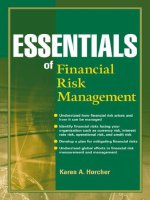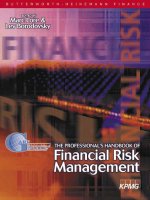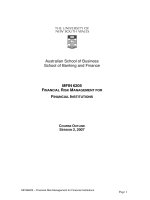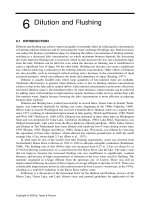Elements of financial risk management chapter 6
Bạn đang xem bản rút gọn của tài liệu. Xem và tải ngay bản đầy đủ của tài liệu tại đây (1.18 MB, 72 trang )
1
Non-Normal Distributions
Elements of
Financial Risk Management
Chapter 6
Peter Christoffersen
Elements of Financial Risk Management Second Edition © 2012 by Peter Christoffersen
Overview
• Third part of the Stepwise Distribution Modeling (SDM)
approach: accounting for conditional nonnormality in
portfolio returns.
• Returns are conditionally normal if the dynamically
standardized returns are normally distributed.
• Fig.6.1 illustrates how histograms from standardized
returns typically do not conform to normal density
• The top panel shows the histogram of the raw returns
superimposed on the normal distribution and the bottom
panel shows the histogram of the standardized returns
superimposed on the normal distribution
Elements of Financial Risk Management Second Edition © 2012 by Peter Christoffersen
2
Figure 6.1: Histogram of Daily S&P 500 Returns
and Histogram of GARCH Shocks
Elements of Financial Risk Management Second Edition © 2012 by Peter Christoffersen
3
Learning Objectives
• We introduce the quantile-quantile (QQ) plot,
which is a graphical tool better at describing tails
of distributions than the histogram.
• We define the Filtered Historical Simulation
approach which combines GARCH with historical
simulation.
• We introduce the simple Cornish-Fisher
approximation to VaR in non-normal distributions.
• We consider the standardized Student’s t
distribution and discuss the estimation of it.
Elements of Financial Risk Management Second Edition © 2012 by Peter Christoffersen
4
Learning Objectives
• We extend the Student’s t distribution to a more
flexible asymmetric version.
• We consider extreme value theory for modeling the
tail of the conditional distribution
• For each of these methods we will consider the
Value-at-Risk and the expected shortfall formulas
Elements of Financial Risk Management Second Edition © 2012 by Peter Christoffersen
5
Visualising Non-normality Using
QQ Plots
• Consider a portfolio of n assets with Ni,t units or shares
of asset i then the value of the portfolio today is
• Yesterday’s portfolio value would be
• The log return can now be defined as
Elements of Financial Risk Management Second Edition © 2012 by Peter Christoffersen
6
Visualising Non-normality Using
QQ Plots
7
• Allowing for a dynamic variance model we can say
• where σPF,t is the conditional volatility forecast
• So far, we have relied on setting D(0,1) to N(0,1), but we
now want to assess the problems of the normality
assumption
Elements of Financial Risk Management Second Edition © 2012 by Peter Christoffersen
Visualising Non-normality Using
QQ Plots
• QQ (Quantile-Quantile) plot: Plot the quantiles of
the calculated returns against the quantiles of the
normal distribution.
• Systematic deviations from the 45 degree angle
signals that the returns are not well described by
normal distribution.
• QQ Plots are particularly relevant for risk
managers who care about VaR, which itself is
essentially a quantile.
Elements of Financial Risk Management Second Edition © 2012 by Peter Christoffersen
8
Visualising Non-normality Using
QQ Plots
9
• 1) Sort all standardized returns in ascending order and
call them zi
• 2) Calculate the empirical probability of getting a value
below the value i as (i-.5)/T
• 3) Calculate the standard normal quantiles as
• 4) Finally draw scatter plot
• If the data were normally distributed, then the scatterplot
should conform to the 45-degree line.
Elements of Financial Risk Management Second Edition © 2012 by Peter Christoffersen
10
Figure 6.2: QQ Plot of Daily S&P 500 Returns
Elements of Financial Risk Management Second Edition © 2012 by Peter Christoffersen
Figure 6.2: QQ Plot of Daily S&P 500 GARCH
Shocks
Elements of Financial Risk Management Second Edition © 2012 by Peter Christoffersen
11
12
Filtered Historical Simulation Approach
• We have seen the pros and cons of both databased and model-based approaches.
• The Filtered Historical Simulation (FHS) attempts
to combine the best of the model-based with the
best of the model-free approaches in a very
intuitive fashion.
• FHS combines model-based methods of variance
with model-free method of distribution in the
following fashion.
Elements of Financial Risk Management Second Edition © 2012 by Peter Christoffersen
13
Filtered Historical Simulation Approach
• Assume we have estimated a GARCH-type model
of our portfolio variance.
• Although we are comfortable with our variance
model, we are not comfortable making a specific
distributional assumption about the standardized
returns, such as a Normal or a ~t ( d ) distribution.
• Instead we would like the past returns data to tell
us about the distribution directly without making
further assumptions.
Elements of Financial Risk Management Second Edition © 2012 by Peter Christoffersen
14
Filtered Historical Simulation Approach
• To fix ideas, consider again the simple example of a
GARCH(1,1) model
• where
• Given a sequence of past returns,
we can estimate the GARCH model.
• Next we calculate past standardized returns from
the observed returns and from the estimated
standard deviations as
Elements of Financial Risk Management Second Edition © 2012 by Peter Christoffersen
Filtered Historical Simulation Approach
• We will refer to the set of standardized returns as
• To calculate the 1-day VaR using the percentile of the
database of standardized residuals
• Expected shortfall (ES) for the 1-day horizon is
• The ES is calculated from the historical shocks via
Elements of Financial Risk Management Second Edition © 2012 by Peter Christoffersen
15
16
Filtered Historical Simulation Approach
• where the indicator function 1(*) returns a 1 if the
argument is true and zero if not
• FHS can generate large losses in the forecast
period even without having observed a large loss
in the recorded past returns
• FHS deserves serious consideration by any risk
management team
Elements of Financial Risk Management Second Edition © 2012 by Peter Christoffersen
The Cornish-Fisher Approximation to
VaR
• We consider a simple alternative way of
calculating Value at Risk, which has certain
advantages:
• First, it allows for skewness and excess kurtosis.
• Second, it is easily calculated from the empirical
skewness and excess kurtosis estimates from the
standardized returns.
• Third, it can be viewed as an approximation to the
VaR from a wide range of conditionally
nonnormal distributions.
Elements of Financial Risk Management Second Edition © 2012 by Peter Christoffersen
17
The Cornish-Fisher Approximation
to VaR
• Standardized portfolio returns is defined by
• where D(0,1) denotes a distribution with a mean
equal to 0 and a variance equal to 1
• i.i.d. denotes independently and identically
distributed
• The Cornish-Fisher VaR with coverage rate, p, can
be calculated as
Elements of Financial Risk Management Second Edition © 2012 by Peter Christoffersen
18
The Cornish-Fisher Approximation
to VaR
• Where
• Where
is the skewness and is the excess kurtosis
of the standardized returns
• If we have neither skewness nor excess kurtosis so that
.
, then we get the quantile of the
normal distribution
Elements of Financial Risk Management Second Edition © 2012 by Peter Christoffersen
19
The Cornish-Fisher Approximation
to VaR
• Consider now for example the one percent VaR,
where
• Allowing for skewness and kurtosis we can
calculate the Cornish-Fisher 1% quantile as
• and the portfolio VaR can be calculated as
Elements of Financial Risk Management Second Edition © 2012 by Peter Christoffersen
20
The Cornish-Fisher Approximation to
VaR
• Thus, for example, if skewness equals –1 and excess
kurtosis equals 4, then we get
• which is much higher than the VaR number from a
normal distribution, which equals 2.33σPF,t+1
Elements of Financial Risk Management Second Edition © 2012 by Peter Christoffersen
21
The Cornish-Fisher Approximation
to VaR
• The expected shortfall can be derived as
• Where
Elements of Financial Risk Management Second Edition © 2012 by Peter Christoffersen
22
The Cornish-Fisher Approximation
to VaR
• Recall that the ES for the normal case is
• Which can be derived by setting
equation for
.
in the
• The CF approach is easy to implement and we avoid
having to make an assumption about exactly which
distribution fits the data best
Elements of Financial Risk Management Second Edition © 2012 by Peter Christoffersen
23
The Standardized t distribution
• The Student’s t distribution is defined by
• Γ(*) notation refers to the gamma function
• the distribution has only one parameter d
• In the Student’s t distribution we have the following
first two moments
Elements of Financial Risk Management Second Edition © 2012 by Peter Christoffersen
24
The Standardized t distribution
• Define Z by standardizing x so that,
• The Standardized t distribution,
defined as
, is then
• where
Elements of Financial Risk Management Second Edition © 2012 by Peter Christoffersen
25









